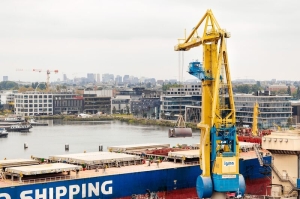


(Posted on 28/04/25)
Port of Amsterdam has achieved its CO? reduction target. The Port of Amsterdam aimed to reduce its corporate CO? emissions by 65% by 2025 compared to 2014 levels — and this goal has been met. Several initiatives contributed to this achievement: some of the port’s locations are now off natural gas, patrol vessels have been made more sustainable and now run on greener fuels, travel policy has been revised, company cars are electric, and a new expense reporting system has been introduced, giving us better insight into the CO? emissions associated with our travel.
The port’s next goal is to be carbon neutral by 2030, and they are on track to achieving it. This target covers what is known as ‘scope 1 and 2’ emissions — meaning emissions resulting from the use of fossil fuels and electricity for buildings, vehicles, and vessels. The 2050 goal is to reduce our scope 3 emissions to net zero as well. These include emissions released during, for example, quay construction (procurement processes) and emissions resulting from purchasing policies. The port is aware that they have not yet identified all emission sources and will use 2025 to gain the best possible insight into this data.
For now, the focus remains on reducing CO? emissions. Ultimately, some emissions will be unavoidable due to the difficulty of making reductions, for example, the office buildings used by the Port of Amsterdam that they do not own. That is why goals refer to being ‘net zero’ or ‘net carbon neutral’ — because, as a company, it’s not possible to operate entirely without CO? emissions.
Making the organization carbon neutral is one of the three pillars of the CO? Reduction Programme. In addition, they focus on two other areas: reducing emissions from shipping and reducing emissions from industry in the port.
The Port of Amsterdam’s Clean Shipping Vision is being implemented. Reducing CO? emissions is one of the key focus areas — and this often goes hand in hand with reducing other harmful emissions. The International Maritime Organization (IMO) has set the ambition of bringing international shipping emissions down to net zero around the year 2050. The Clean Shipping Vision aims even higher: a shipping sector that is entirely emission-free by 2050 at the latest. In the port, they are focusing on the availability and use of sustainable maritime fuels, emission-reducing technologies (such as shore power), rewarding front-running sustainable vessels through incentives, and ensuring efficient port operations for shipping.
The ten most energy-intensive companies are responsible for a significant share of all emissions in the port area.
Together with these companies and the City of Amsterdam, the port is working to reduce these emissions. The goal is for all companies in the port to have net-zero scope 1 and 2 greenhouse gas emissions by 2050 at the latest, and to actively work on minimizing their scope 3 emissions. Greater availability of electricity and access to hydrogen are crucial to achieving this.
The port is also developing a CO? value chain, with projects focused on carbon capture, storage, and reuse.
Abu Dhabi based AD Ports Group, a global enabler of integrated trade, transport, industry, and logistics... Read more
This year marks a significant milestone in maritime innovation as Port Hedland, Australia, celebrates... Read more
Associated British Ports (ABP), the UK’s leading port operator, has announced the latest tranche... Read more
During the Investment, Labour, and Trade Promotion Programme in Japan (November 16–22, 2025),... Read more
AD Ports Group subsidiary Khalifa Economic Zones Abu Dhabi - KEZAD Group, the largest operator of integrated... Read more
Abu Dhabi based AD Ports Group, a global enabler of integrated trade, transport, industry, and logistics... Read more
Peel Ports Group has achieved a 48% reduction in operational greenhouse gas emissions in the last five... Read more
The Trois-Rivières Port Authority (TRPA) in Canada has announced the appointment of Mr. Anick... Read more
Euroports commitment to continuously improving operational efficiency, enhancing workplace safety, and... Read more
Under the slogan ‘Your Intermodal Link Between China, Iberia and the Atlantic Markets,’... Read more